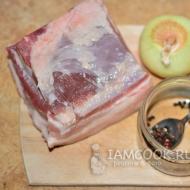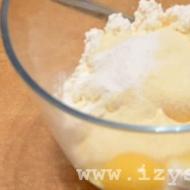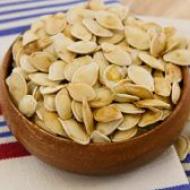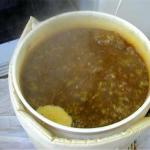
What to do if your dog has eaten a lot of chocolate. Sweet poison: why shouldn't dogs be given chocolate? Counterfeits passing off as chocolate
Yes, chocolate is poisonous to dogs. Although poisoning is rarely fatal, chocolate can cause significant harm to a dog if ingested. Chocolate is poisonous due to the methylxanthine theobromine it contains. Theobromine is similar to caffeine and is used medicinally as a diuretic, cardiac stimulant, and muscle relaxant. Theobromine is poisonous and, if left untreated, can cause serious illness.
How much chocolate is poisonous to a dog?
Theobromine becomes toxic after an approximate dose of 20 mg per kg of dog's weight when the dog becomes agitated, hyperactive, and has various gastrointestinal symptoms (salivation, vomiting, diarrhea). At doses greater than 40 mg/kg, cardiac symptoms such as rapid heartbeat, high blood pressure and even arrhythmia appear. At doses greater than 60 mg/kg, neurological symptoms such as tremors, twitching and seizures appear. A dose of more than 100-200 mg/kg, or if complications arise from smaller doses, can be fatal for the dog.
The amount of theobromine depends on the type of chocolate. Dark and bitter chocolate is more dangerous for dogs than regular chocolate. High quality dark chocolate contains between 130 and 450 mg of theobromine per ounce, while regular milk chocolate contains only about 50 mg per ounce. White chocolate in small quantities usually does not pose any risk of poisoning, however, it can still make your dog sick as chocolate contains fats and sugars that can lead to pancreatitis.
What are the symptoms of chocolate poisoning?
Clinical symptoms depend on the amount and type of chocolate. For most dogs, symptoms of poisoning include vomiting and diarrhea, thirst, panting, restlessness, excessive urination, rapid heartbeat, muscle spasms (tremors), and sometimes seizures. Older animals that eat large amounts of dark chocolate may have a heart attack, especially if they have heart disease. Complications such as aspiration pneumonia resulting from vomiting can make poisoning even more dangerous. If you are unsure about your dog, contact your veterinarian immediately to begin treatment as quickly as possible.
Symptoms of chocolate poisoning may take several hours to develop, but they take much longer to resolve. Symptoms may last several days, depending on the rate at which theobromine is eliminated. Theobromine can also be reabsorbed into the body from the bladder, so frequent walking is recommended.
What to do if your dog eats chocolate?
If you see that your dog has eaten chocolate, immediately call the animal helpline or your veterinarian. The veterinarian will tell you the next steps. You may need to induce vomiting in your dog even if he shows no symptoms of poisoning. The faster you remove theobromine from your dog's body, the less harm it will cause him.
How to treat chocolate poisoning?
Treatment depends on the amount and type of chocolate eaten. If treatment is started in the early stages, either by cleansing the stomach or using activated charcoal, then no further treatment is likely to be required. Activated charcoal can be used every 4-6 hours for the first 24 hours after poisoning to reduce absorption and further recycling of theobromine.
Often, therapeutic treatment, such as an intravenous drip, is prescribed to weaken the effect of the toxin and promote its release. All dogs that have consumed chocolate should be carefully monitored for symptoms of vomiting, diarrhea, nervousness, abnormal heart rhythms and high blood pressure. Medicines that slow the heart rate are often used
There are dog treats that contain chocolate, aren't they dangerous?
Many dog owners use chocolate substitutes such as carob. Some dog-friendly treats contain small amounts of milk chocolate, which, due to its low theobromine content, is safe for most dogs. However, veterinarians recommend avoiding feeding dogs any forms of chocolate. Remember that the ingredients used in the products are listed in descending order by weight!
Pet owners treat their pets like family members. A side effect of the owner’s all-consuming love is the desire to pamper the pet and treat it to something tasty. And often the role of a delicacy is what most people recognize as the most delicious sweet in the world - chocolate. This product is a poison for dogs that can cause terrible consequences - from diarrhea and vomiting to a heart attack.
What is chocolate made of? In answer to this question, anyone can name cocoa beans. And, undoubtedly, he will be aware of the beneficial effects of this fruit on the body. But the human and dog bodies are naturally different. And what is useful to people poses a real threat to their pets.
Important! It is not at all necessary that your dog will drop dead after eating a piece of chocolate. But if it is a certain type of sweet (the darker and more natural the chocolate, the more dangerous), if the size and weight of the dog are small, and the consumed portion of the sweet product is impressive, there will be an immediate threat to the health and even life of the pet.

Source of the problem
If we look in detail at the source of the problem, called theobromine, which, undoubtedly, should be done by all “dog lovers” or those who are planning to have a pet, the following can be said about this substance.
- Theobromine is of plant origin.
- It belongs to the group of methylxanthines.
- This alkaloid gives chocolate a bitter taste.
- Similar in characteristics to caffeine.
- It does not pose any threat to humans, since it is removed from it as soon as it gets there.
- For a dog, the decay period of the substance is 17.5 hours. During this time, it manages to fully exert its toxic effect.
This substance is widely used in medicine, like caffeine. It is used:
- as a component of diuretics;
- to dilate blood vessels;
- to stimulate the heart;
- as a muscle relaxant.

Types and contents
Different types of cocoa containing products contain theobromine in different doses.
Table. Doses of theobromine by type of chocolate products
From this table it follows that for a twenty-kilogram dog, a toxic dose would be, for example, 250 grams of dark chocolate with high cocoa content or almost a kilogram of milk chocolate. For a dog weighing five kilograms, the dose is reduced by four.
Important! A dose of theobromine of 100 mg per kilogram of animal weight is toxic for a dog. Therefore, the smaller the dog, the smaller the dose is sufficient for poisoning.

Consequences
So, treating your pet with a piece of white chocolate or chocolate candy, at first glance, is not so scary. But the problem is that most dogs become devoted fans from the moment they try this treat. And subsequently, as soon as the owners gape and leave a bar of a sweet product or a box of chocolates in a visible place, it will be opened and eaten in the blink of an eye.
By the way. If the amount of theobromine in the chocolate destroyed by a pet does not exceed the critical norm for the animal, obvious consequences may not occur. At most, the dog faces a mild stomach upset.
If a substance is consumed in a dose dangerous to health, the following may happen to a dog:
- severe stomach upset;
- vomit;
- severe diarrhea;
- muscle tremors;
- internal bleeding;
- seizure attack;
- interruptions in heart rhythm;
- heart attack.

If the dog ate chocolate
The owners are aware that chocolate is not allowed for the pet. But dogs are smart and quick-witted creatures. And now there is only one wrapper left of the chocolate, an empty, torn candy box lies on the floor, and the pet, at first glance, is cheerful, content and active.
Don't flatter yourself. Take the following steps.
- Calculate how much theobromine has entered your pet's stomach.
- Relate this number to the dog's weight.
- Observe its behavior - the beginning of the poisoning process is characterized by the animal's hyperactivity.
- Then activity will give way to lethargy, and signs of gastric distress will appear.
Important! In case of a critical dose, without waiting for signs of poisoning to appear, it is necessary to take the animal to a veterinary clinic.

Signs of theobromine poisoning
It may happen that wrappers and boxes are not immediately discovered. And the owner still has no idea that the pet has destroyed the family's chocolate stock. But based on the following signs that appear, you can quickly guess that something is happening to the dog.
- Theobromine is a central nervous system stimulant, which means that the animal’s heart rate will accelerate and arrhythmia will begin.
- It is a diuretic, the dog will begin to suffer from frequent urination, which threatens dehydration, despite the fact that the dog will be thirsty.
- Allergies may begin.
- The animal's breathing will become frequent and intermittent.
- Vomiting will begin, and diarrhea may begin.
- During convulsions, coma can develop, and the animal can die.
Help
Self-medication should not be done, since without the intervention of a veterinarian, the pet may be more likely to be harmed than helped. But still, within two hours after the chocolate has been eaten, if dangerous consequences occur, you can try to induce vomiting in your pet, if there is no vomiting. It is also necessary to give him plenty of water to drink.

Advice. The main thing is to get the animal to the veterinarian as soon as possible. At the veterinary clinic, he will undergo gastric lavage, and this will help avoid dangerous health consequences.
You can feed your dog crushed activated carbon, one tablet per 10 kilograms of the animal’s weight. Be sure to drink plenty of water. In the future, charcoal should be given to your pet at four-hour intervals to enhance absorption.
Your veterinarian may administer intravenous infusion therapy to dilute the toxin and speed its release.
Also, if necessary, the animal may be prescribed a drug that slows down the heart rate.
Video - Products dangerous for dogs
Other dangers
In addition to theobromine, food chocolate contains many other components that, to a lesser extent, also pose a danger to dog health.
- A lot of sugar - if it is consumed excessively and frequently, the animal can develop diabetes.
- Flavorings – may cause allergies.
- Dyes are also toxins and harmful in large doses.
- Flavoring additives, nuts, and so on, putting a strain on the animal’s pancreas.
How not to feed your pet chocolate
- Well, first of all, just don’t give your dog this product, ever, in any form. Neither as a treat, nor as a reward.
- Secondly, adult family members need to ensure that children do not share sweets with their pets.
- Thirdly, you should not store chocolate products within your pet's sight.
- Fourthly, do not underestimate your dog, many of them know how to open cabinets and even refrigerators and perform gymnastic miracles when their owners are not at home.

Important! If you have a dog at home, especially a small one, and you are a lover of sweets, in particular dark chocolate, this product should be kept exclusively under lock and key.
Although in veterinary practice, death after eating chocolate in dogs is rare, severe poisoning is also a high danger and stress, both for the pet and for its owners. Especially in the absence of treatment and failure to provide assistance, the consequences can be serious.
What to do? How to accept the fact that your beloved dog will never taste chocolate in his life? There is a solution - special chocolate for dogs.
Video - Products harmful to dogs
Chocolate that dogs can eat
Chocolate made specifically for dogs contains neither cocoa nor sugar. But it contains substances that are beneficial to dogs:
- lecithin;
- stevia;
- carob powder;
- blood albumin;
- dairy products;
- yeast;
- Palm oil;
- lactose;
- vitamins.
Table. Chocolate brands for dogs
| Brand | Image | Description |
|---|---|---|
 | Russian brand that produces the product Choco Dog | |
 | Germany - product called Schoco Dog Chocolate | |
 | Germany – produces shock drops | |
 | Also a German brand that makes chocolate drops |
Advice. As with any product, chocolate for dogs must be handled carefully, not allowing your pet to consume it in unlimited quantities. The treat must have an appropriate status.
In small doses, dog chocolate will become not only a tasty treat for your pet, but also a healthy product, the use of which will improve the condition of the coat, claws, and teeth.
Incredible facts
Chocolate in surprisingly small quantities can seriously affect your dog's health, causing death in some cases. Veterinarians around the world have reportedly repeatedly encounter in their practice cases of severe intoxication in our smaller brothers, caused by the consumption of certain doses of chocolate. Moreover, the greatest danger to animals is the so-called healthy dark chocolate (useful for humans), although milk chocolate can also be a deadly poison. It all depends on the dose.
Why is chocolate so dangerous for dogs? Exactly how much chocolate does your pet have to eat for it to become toxic? What are the general symptoms of chocolate poisoning in dogs? And finally, what should you do if your four-legged friend eats a dangerous dose of chocolate? You will find answers to all these questions in this article.
As you know, the most toxic components of chocolate are caffeine and theobromine. It is theobromine, which is contained in high concentrations in this delicacy, and causes the largest number of poisonings among dogs. The problem is that theobromine affects the animal's digestive system, nervous system (brain), as well as the cardiovascular system (including the lungs and heart) and kidneys.

Symptoms of chocolate poisoning in dogs depend on the amount of chocolate eaten, the type of chocolate, and how long ago the chocolate was eaten. The most common symptoms of such poisoning are gastrointestinal manifestations, such as stomach upset, bloating, vomiting and diarrhea. It is not so rare to observe an increase in the animal’s activity, restlessness, increased heart rate, as well as frequent urination and the desire to drink. The most serious symptoms occur when the nervous system is affected. In this case, seizures, fever, rapid breathing, increased body temperature (hyperthermia) and even coma may occur.
Chocolate weighing 140 g contains 250 mg of theobromine. A dose of chocolate that contains 60 milligrams of theobromine per kilogram of the animal’s weight is definitely toxic and potentially fatal to a dog’s life. Thus, a dog that weighs 4.5 kilograms will only need to eat a bar of chocolate containing 300 milligrams of theobromine for intoxication to begin. Clinical symptoms will be noticeable already after consuming 20 milligrams of theobromine per kilogram of weight(a dog with the same weight - 4.5 kilograms - will begin to show signs of poisoning after consuming one hundred grams). Moreover, serious symptoms can be recorded after consuming 40 milligrams per kilogram of weight (that is, after two hundred grams of chocolate for the example given).

So, if we are talking about, say, a poodle weighing 4.5 kilograms, even one bar of milk chocolate containing 250 milligrams of theobromine can be fatal for such a dog. At the same time, a dog weighing up to 40 kilograms or more (eg golden retriever), would have to eat as many as 8 bars of milk chocolate for serious symptoms of poisoning to appear. At the same time, dark chocolate and confectionery chocolate are much more toxic! For the same retriever, just three bars of dark chocolate can be fatal.
How to help a dog poisoned by chocolate?
If your four-legged pet eats chocolate, you should try to find out exactly how much of this treat was eaten. Then, considering the type of chocolate as well as taking into account the information provided earlier in this article, all that remains is to estimate how high the probability of toxic poisoning of the animal is. If the dose of chocolate exceeded 20 milligrams per kilogram of the animal’s weight, it is necessary to induce vomiting in the animal (at home or by visiting a veterinarian’s office).

If we talk about ways to induce vomiting in your pet, then you can use hydrogen peroxide - one teaspoon for every 4.5 kilograms of the dog’s weight. If such a dose does not cause vomiting in the animal within 10 minutes, it is necessary to repeat the administration of the emetic. At the same time, some experts It is not recommended to use more than two repetitions when it comes to hydrogen peroxide. You can also use a saline solution: one teaspoon of salt to one tablespoon of water. This is a dose for every 4.5 kilograms of animal weight. If you are unable to induce vomiting in your dog, or if your dog is experiencing excessive vomiting, diarrhea, seizures, and fever, you should take him to the vet immediately.
So, as you see, not everything that brings pleasure and joy to people is useful to our little brothers. And if you have taken upon yourself the responsibility of caring for your four-legged friend, you should also be attentive to his diet. Make sure your dog doesn't accidentally eat even a small piece of chocolate. (not to mention giving her chocolate on purpose!). Be vigilant about the health of your dog, be able to recognize the symptoms of poisoning and master the rules of first aid. Otherwise, even a small mistake can cost your pet his life.
How we love to pamper our pets...giving away the last piece of a burger or sharing chips with a four-legged dog is a common thing. Sweeten the dog’s life with caramel, reassuring yourself with the phrase: “Well, just one piece of candy won’t do anything.” Sound familiar? Let’s not cast a “twilight” and scare you over trifles; one caramel or a cube of milk chocolate really won’t do anything, but in the human world there are also products that can be regarded as pure poison for animals. Do you think dogs can have chocolate? Intuitively you understand that it is impossible, but why? Let's figure it out.
Chocolate and confectionery in general are a separate stronghold of the achievements of the food industry. Have you ever wondered why the price of a chocolate bar ranges from $1 to $20? Is it really just about the brand? Of course not. There are only two types of chocolate in the world:
- Powder– dry cocoa grains, ground with powdered sugar.
- Liquid– the same powdered chocolate, with the addition of natural cocoa butter.
The basis of the product is cocoa beans, which are divided into noble and consumer grades. And now, drum roll, only the remnants of consumer varieties of cocoa reach the shelves of retail chains, and almost the entire “useful part” of the fruit is used in the production of medicines. Moreover, to reduce the cost of the product, ground bean shells and technical residues (that is, garbage) from the production of natural powdered chocolate are often used as raw materials.
This is interesting! Cocoa trees grow only in the tropics. Each tree produces 30–50 beans in one fruiting season. One fruit reaches a maximum size of 2.5 cm. Only bean pulp is used to produce chocolate, that is, 75–80% of the original product. Now think about how big the cocoa tree plantations must be to provide the amount of chocolate products that we see on store shelves?
Read also: How to wean a dog from sleeping on the bed with its owner - 5 simple methods
Counterfeits passing off as chocolate
So, we know that dogs can’t have chocolate, you hide treats on the top shelves, fearing for your pet’s health. One day, you forget to hide a harmful product and observe the following picture - the dog ate chocolate, hiccupped and fell asleep in a blissful sleep... maybe this prohibition is not so strict? This is far from true, you were simply deceived by the producers of that very “chocolate” and thereby saved your pet from poisoning. Counterfeit chocolates masquerading as treats also carry risks such as diabetes, hormonal imbalances, excess weight gain and indigestion... but real chocolate can kill your pet. So what is fake chocolate?

We take the tile wrapper and read:
- We see it contains chocolate, without the dessert prefix. You have been deceived, this product is not made for consumption as a delicacy, however, it is real chocolate and you can’t argue with that. Read on.
- We find the next key ingredient: grated cocoa beans or cocoa powder - in the second case, this is not chocolate, but a high-calorie squeeze from production residues.
- The most valuable and expensive cocoa butter is replaced with vegetable oils, including industrial palm oil.
- Water, soybeans, legumes, except cocoa, protein inclusions are allowed only in minimal quantities and should be at the end of the list of product composition.
If you are tormented by the question of the relevance of the above information, be patient a little, then everything will become clear. After all, we are looking at the dangers of chocolate for dogs... real and not real chocolate. In the second case, it is quite difficult to describe the consequences, since it is difficult to predict exactly how the manufacturer will reduce the cost of the product. Too much water or beans will lead to indigestion. And adding xylitol as a sweetener can lead to serious poisoning.
Read also: Why does a dog itch if there are no fleas: a list of possible reasons
Why is natural chocolate dangerous for dogs?
If a noble delicacy poses a mortal danger, then chocolate must contain a substance that is poisonous to dogs?

Let's look at the composition of cocoa beans to dispel all questions and doubts:
- Vegetable fats– cocoa beans contain very healthy fat, it contains vitamins and immunostimulants, and it is absorbed almost completely.
- Alkaloids– here everything is not so radiant. Without going into too much terminology, an alkaloid is a substance that allows you to experience artificial pleasure, which is pumped up by intoxicating brain cells. For humans, in small quantities, this effect is even useful, since it allows you to relieve nervous tension.
- Caffeine– also an alkaloid, but stronger and more addictive. It affects the body like a whip, spurring the nervous system to activity. Fortunately, chocolate does not contain as much caffeine as is commonly believed.
- Proteins, minerals, acids- in minimal quantities.
- Tannins– there are few of them, but they also negatively affect brain neurons. From the name it is clear exactly how the substances act on biological cells. For example, it must be said that tannin extract is used for the industrial processing of animal skin.
Important! Do you want to pamper your pet with chocolate? Buy specialized products at a pet store! Chocolate for dogs and cats is relatively safe if you follow the recommended dosage.
Chocolate is on the list of prohibited foods for dogs, which is quite justified. Dogs are not allowed chocolate because it can cause poisoning and, in some cases, death.
Therefore, do not be fooled by the questioning eyes of your pet, justifying yourself by saying that you cannot refuse him, because you love him so much, and he looks so pitifully. A loving owner will not provide foods that are dangerous for the dog, and for pampering and encouragement there are special healthy treats, including chocolate for dogs, which dogs like.
Why dogs can't have chocolate
This product is not suitable for dogs due to some of the ingredients it contains. First of all, cocoa beans contain the alkaloid theobromine, which is poisonous to animals. Theobromine is absorbed slowly and can remain in the blood for up to 20 hours, while interfering with the normal functioning of the cardiovascular, nervous system, and kidneys.
Different types of chocolate contain different amounts of theobromine, but the most dangerous are cocoa beans (cocoa bean mulch is also dangerous), cocoa powder, and dark chocolate. Milk and white contain the least amount of theobromine, but this does not mean that they can be fed to your pet.
Lethal dose of chocolate: 100-200 mg per 1 kg of dog’s body weight.
An animal can be poisoned by 15-80 mg per 1 kg of weight.
The smaller the dog, the less of this sweet product is needed for it to become poisoned.
The second reason why dogs should not have chocolate is the presence of sugar contained in this product. In large quantities, sugar puts a strain on the pancreas, resulting in diabetes mellitus.
In addition, this product often contains dyes, flavorings, fragrances, stabilizers and other additives that are harmful to humans, let alone to dogs.

Symptoms of dog poisoning from chocolate
Symptoms of poisoning do not appear immediately, but only after about 3-4 hours, so being sure that the dog has eaten a dangerous product, you should immediately show it to the veterinarian, where the pet will be given gastric lavage, given appropriate adsorbent drugs, and, if necessary, laboratory tests will be carried out.
Small amounts of this product may cause vomiting, diarrhea, and temporary stomach upset. At the same time, the animal experiences thirst, as a result of which it often drinks water.
Theobromine promotes the release of adrenaline, so your pet may experience increased heart rate, unnatural activity, increased body temperature, increased urination, and tremors.
If you regularly feed chocolate, but in small quantities, problems with fur, skin, eyes, kidneys, and blood circulation arise. This product may cause kidney failure and pancreatitis.
Dogs may experience an allergic reaction if there is an individual intolerance to this product. Chocolate is especially dangerous for dogs that have health problems, such as epilepsy or pancreatic diseases.
A large amount eaten at a time leads to convulsions, coma and death.

The degree of poisoning depends on the amount of chocolate eaten, the size of the dog, the body’s sensitivity to this product, and the type of chocolate (the darker, the more poisonous).
According to statistics, dogs are more likely to be poisoned by chocolate, and deaths are rare. However, poisoning also causes a lot of troubles and health problems.
How to protect your pet
To avoid serious consequences, you should keep this product out of the reach of animals, especially if you know that the dog is cunning and quick-witted, sniffs out its favorite treat, begs for it and can eat it at any opportunity.
You shouldn’t indulge in small pieces either, even occasionally. Dogs are not allowed chocolate, in any form, be it candies with icing, baked goods, desserts, and in no quantity. There are special treats for dogs that are safe for the health of the pet.
A small piece or candy will not harm a medium or large pet, but for small breed dogs, such as a Yorkshire terrier, it can be fatal. The more chocolate eaten, the more serious the consequences.
















